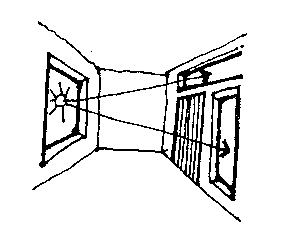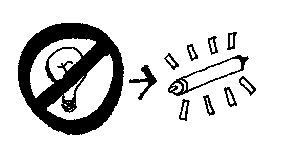| Lighting
Design Considerations:
Natural daylighting- Daylighting should be incorporated wherever
possible as it will increase the quality of the indoor environment and reduce lighting
loads. People have a biological need to see natural daylight. Diffused natural
light utilized with pale reflecting materials and supporting systems will result in an
optimal lighting design.
Artificial Lighting- Use T-8 tubular fluorescent lamps which are much
more efficient, accurate, and pleasant in color. Use sodium lamps to reduce the
amount of energy consumption. CFLs- compact fluorescent lamps- use one quarter as
much electricity and last ten times longer than incandescents, are dimmable and available
in many sizes, shapes and wattages.
Lamp disposal is hazardous waste- even in miniscule amounts, mercury can be highly
toxic.
Dispose of lamps in EPA-approved MSW and the generator needs to keep records for at
least three years of where the lamps were sent.
Utilize long-life fluorescent bulbs that are energy efficient
Photosensoring devices- Photosensoring devices can be used
to detect natural light levels, then trigger appropriate levels of supplemental artificial
lighting.
Smart lighting automatically adjusts to the desirable level of lighting that is
desired.
Circuiting and Switching -Separate circuiting and switching should be
provided for different tasks and zones. Light controls should be easily accessible
so that occupants can readily make lighting adjustments.
Occupancy Sensors -Utilize occupancy sensors throughout building to
conserve energy when spaces are unoccupied for more than five minutes.
Interior windows -Incorporate interior windows into enclosed spaces in
order to maximize the amount of daylighting
Interior paint colors and finish textures- Ceilings and walls should
be painted with a high reflectance, non-toxic paint to maximize light quality
Tools:
Consult the Green Lights Program implemented by the Environmental Protection Agency
Consult the product requirements as dictated by the EPACT legislation of 1992
Case Studies to Research:
Center for Energy and Environmental Education University of Northern Iowa
Cedar Falls, IA.
Wells Woodburn O’Neil
-Body Shop U.S. Headquarters, Wake Forest, NC
Design Harmony Inc.
-National Audubon Society Headquarters, New York, NY
Croxton Collaborative Architects, NY
-Paulk Residence, Seabeck, WA.
James Cutler Architects
-Herman Miller- Miller SQA Facility
Zeeland, MI.
William McDonough + Partners
-Inland Revenue Center, Nottingham, England
Michael Hopkins and Partners, Architect
Further Information:
“High Dividends” Buchanan, Peter. Architecture. Vol.84, no.7, July
1995, pp.76-83.
“Campus Energy” Barreneche, Raul A. Architecture. Vol.84, no.7, July 1995,
pp.98-103.
Moore, F. Environmental Control Systems: Heating, Lighting, Cooling. New
York: McGraw-Hill, Inc, 1993.
National Audubon Society Audubon House: Building the Environmentally Responsible,
Energy-Efficient Office. New York, NY: John Wiley and Sons, Inc. 1994
The Ecology of Architecture: A Complete Guide to Creating the Environmentally
Conscious Building by Laura Zeiher.
Green Lights Program, EPA
The Consumer Guide to Home Energy Savings
Primer on Sustainable Building, Rocky Mountain Institute |



